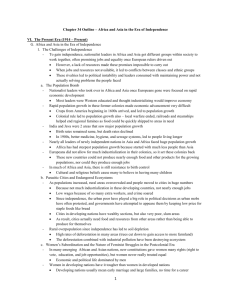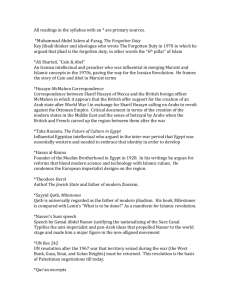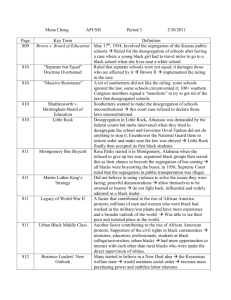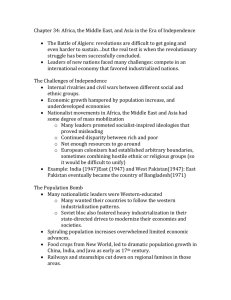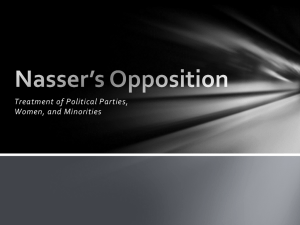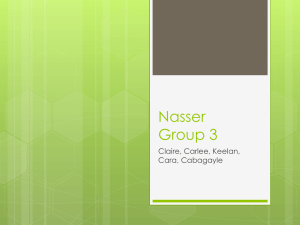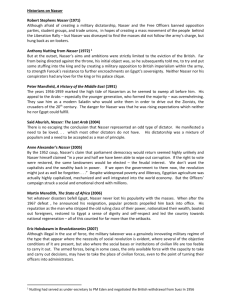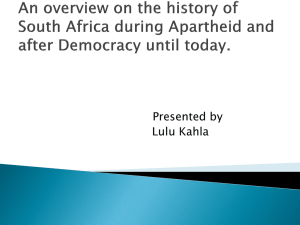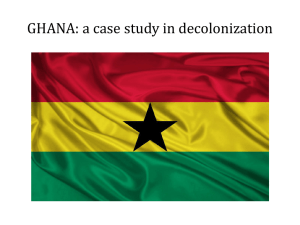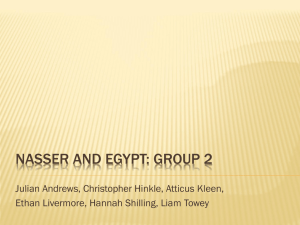DECOLONIZATION IN AFRICA: FOUR CASE STUDIES
advertisement
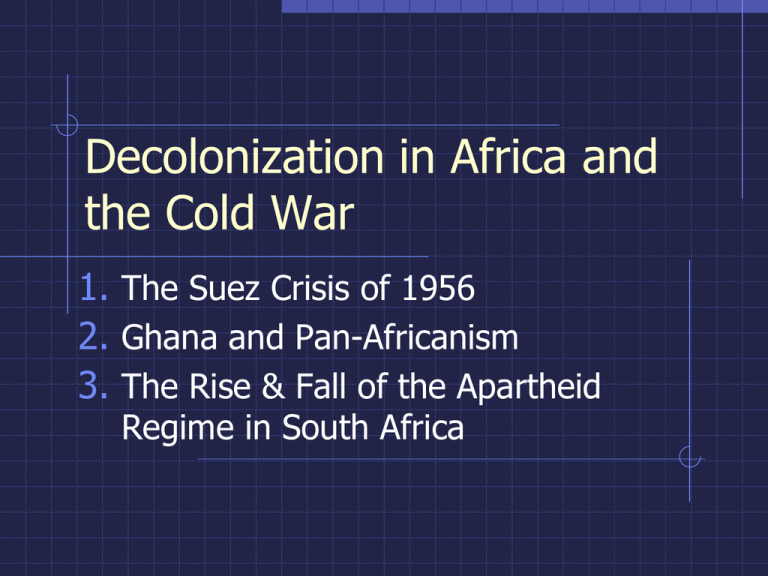
Decolonization in Africa and the Cold War 1. The Suez Crisis of 1956 2. Ghana and Pan-Africanism 3. The Rise & Fall of the Apartheid Regime in South Africa Wedding Banquet for King Farouk (reigned 1936-1952) and Queen Farida, Alexandria, 1938 The pan-Arabist Egyptian Major Gamal Abdel Nasser (1918-1970) suffered defeat in Gaza in 1948 but toppled the Egyptian monarchy in 1952 and nationalized the Suez Canal in 1956 Sir Anthony Eden and Guy Mollet reached a secret agreement with David ben-Gurion in October 1956 to bring Nasser down The French sought to cut off support for Algerian rebels EDEN WROTE EISENHOWER on September 6, 1956, to compare Nasser with Hitler and Stalin “The seizure of the Suez Canal is, we are convinced, the opening gambit in a planned campaign designed by Nasser to expel all Western influence and interests from Arab countries. He believes that if he can get away with this his prestige in Arabia will be so great that he will be able to mount revolutions of young officers in Saudi Arabia, Jordan, Syria and Iraq. (We know that he is already preparing a revolution in Iraq.) These new Governments will in effect be Egyptian satellites if not Russian ones. They will have to place their united oil resources under the control of a United Arabia led by Egypt and under Russian influence.” EISENHOWER replied on September 8 to urge a “slower and less dramatic process then military force.” “I think all Arabs would be forced to support Nasser [if Great Britain attacked], even though some of the ruling monarchs might very much like to see him toppled…. There are economic pressures which, if continued, will cause distress in Egypt. There are Arab rivalries... which can be exploited if we do not make Nasser an Arab hero. There are alternatives to the present dependence upon the Suez Canal. Nasser thrives on drama. If we let some of the drama go out of the situation and concentrate on the task of deflating him through slower but sure processes such as I described, I believe the desired results can more probably be obtained.” In November 1956 France and Britain used the excuse of Israel’s invasion of the Sinai to demand the right to reoccupy the Suez Canal The British amphibious assault on Port Said, November 1956 After the bombing of Port Said, the Soviet ambassador to the UN said the same fate could befall Paris and London. Eisenhower’s comment: “I have just never seen great powers make such a complete mess and botch of things.” Canadian UNEF soldiers patrol the Israeli-Egyptian border, 1962 DECOLONIZATION IN AFRICA: THE SETTLER VARIABLE…. The ratio between European settlers and indigenous peoples was the most important variable governing the outcome of decolonization…. 1. Ghana, 1:10,000. Independent in 1956 following nonviolent struggle led by Joshua Nkrumah. 2. Kenya, 1:100. The British defeat Mau Mau insurgency, then grant independence to Jomo Kenyatta in 1963. 3. Algeria, 1:8. Independent in 1962 after 7 years of horrific bloodshed (analyzed by Frantz Fanon). 4. South Africa, 1:4. Afrikaners establish apartheid regime until 1994, when Nelson Mandela is elected President. The Partition of Africa, 1878-1914: The process was driven forward by politicians who promised economic benefits for Europe that rarely materialized…. Vegetation Zones of Africa: Only the Mediterranean coast, East African highlands, and South African grasslands ever attracted European settlers. Map of Ghana and its ten regions: Over 250 languages and dialects are spoken, but only nine have official status Elmina Castle, Accra, built by the Portuguese in 1483, the oldest center of the transatlantic slave trade The King of Ashanti presides over the Yam Festival, 1817 Kwame Nkrumah (1909-1972): Educated at Lincoln University (PA) and the London School of Economics; returned to the Gold Coast in 1947; pictured here as Prime Minister in 1953: A “nondenominational Christian and Marxist socialist” Nkrumah waves to the crowd in Accra on Independence Day, March 6, 1957 (where Vice President Nixon met Martin Luther King) Nkrumah and his wife dance with traditional chiefs, January 1963: He preached pan-Africanism, but even within Ghana, regionalism remained dominant Africa as of 1964, decolonized except for Angola, Mozambique, South Africa, and Rhodesia Southern Africa in 1885 General Robert leads 43,000 British troops across the Zand River, 10 May 1900: The British crushed Afrikaner resistance in the Boer War but appealed by 1910 for their collaboration in the Union of South Africa Jan Smuts (1870-1950), liberal Afrikaner Prime Minister of South Africa, 1919-1924, 1939-1948 Daniel Malan, architect of apartheid, Prime Minister of South Africa, 1948—1954 Map of the “homelands” created by the apartheid regime Langa Township, outside Capetown, founded in 1927, and Soweto, outside Johannesburg, which became the largest and poorest RACIAL INEQUALITY IN SOUTH AFRICA, ca. 1978 BLACKS WHITES Population 19 million Land allocation 13% Share of national income Under 20% 4.5 million 87% 75% Ratio, per capita income Doctors/ population Infant morality rate 1 1/ 44,000 20% (urban) 40% (rural) $45 14 1/ 400 2.7% 1/ 60 1/ 22 Annual spending on education per pupil Teacher/ pupil ratio $696 “The Congress of the People,” Johannesburg, 1955 Nelson Mandela burns his pass, 1959 The Sharpeville Massacre, 21 March 1960: 72 killed, 178 wounded The prison at Robben Island, where Nelson Mandela sat from 1964 to 1990 Soweto high school students demonstrate in 1976 against the introduction of Afrikans as a required subject Pik Botha, Henry Kissinger, and Magnus Malan in Pretoria, 1970s THE CHANGING RACIAL BALANCE IN SOUTH AFRICA YEAR: White Colored Indian African 1911 21% 9% 3% 67% 1936 21% 8% 2% 69% 1960 19% 9% 3% 68% 1980 16% 9% 3% 72% 1993 13% 8% 3% 76% F.W. de Klerk, who became President in 1989, concluded that majority rule was inevitable Mass rally in Johannesburg, shortly before the release of Mandela in 1990 Poster for ANC march for democracy, March 1991 Chief Mangosuthu Buthelezi, leader of the “Inkatha Freedom Party,” marches with Zulu warriors Terrified residents arm themselves against Inkatha Zulu militants in Kagiso, West Rand, in the early 1990s A member of the “Afrikaner Resistance Movement” attacks a black demonstrator, 1992 The ARM failed in March 1994 to prevent majority rule in Bophuthatswana THE RESULTS OF MULTI-RACIAL ELECTIONS 1994 ANC 2004 62.7% 69.7% Pan-Africanist Congress 1.2% 0.7% Inkatha Freedom Party 10.5% 7.0% Nationalist Party (in 2004 the Dem. Alliance) 20.4% 12.4% Still in 2004, the DA posed a challenge to the ANC in the West Cape, and Inkatha, in KwaZulu-Natal The newly elected President of South Africa, Nelson Mandela, speaks from the balcony of Town Hall in Pretoria, 10 May 1994 TRENDS IN PER CAPITA GDP SINCE 1900: THE GAP BETWEEN RICH AND POOR WIDENS $45,000 $40,000 $35,000 $30,000 USA France $25,000 Japan $20,000 South Africa India $15,000 Ghana $10,000 China $5,000 $0 1900 1950 1973 2004
